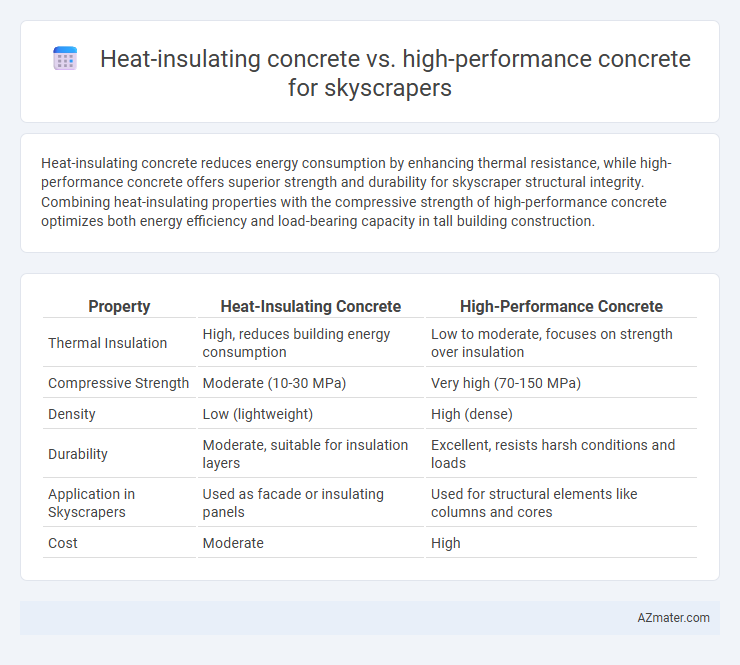Heat-insulating concrete reduces energy consumption by enhancing thermal resistance, while high-performance concrete offers superior strength and durability for skyscraper structural integrity. Combining heat-insulating properties with the compressive strength of high-performance concrete optimizes both energy efficiency and load-bearing capacity in tall building construction.
Table of Comparison
| Property | Heat-Insulating Concrete | High-Performance Concrete |
|---|---|---|
| Thermal Insulation | High, reduces building energy consumption | Low to moderate, focuses on strength over insulation |
| Compressive Strength | Moderate (10-30 MPa) | Very high (70-150 MPa) |
| Density | Low (lightweight) | High (dense) |
| Durability | Moderate, suitable for insulation layers | Excellent, resists harsh conditions and loads |
| Application in Skyscrapers | Used as facade or insulating panels | Used for structural elements like columns and cores |
| Cost | Moderate | High |
Introduction to Modern Concrete Technologies in Skyscraper Construction
Heat-insulating concrete integrates advanced thermal resistance materials to minimize energy loss in skyscraper envelopes, significantly enhancing building energy efficiency and occupant comfort. High-performance concrete (HPC) delivers superior strength, durability, and reduced permeability, enabling slender structural elements and increased load-bearing capacity crucial for towering skyscrapers. Both technologies represent pivotal advancements in modern concrete, with heat-insulating concrete prioritizing thermal management and HPC emphasizing structural optimization in skyscraper construction.
Defining Heat-Insulating Concrete: Features and Functions
Heat-insulating concrete incorporates lightweight aggregates and specialized admixtures to reduce thermal conductivity, enhancing energy efficiency in skyscraper construction. Its key features include superior thermal resistance, lower density, and moisture control capabilities, which contribute to maintaining stable indoor temperatures and reducing HVAC loads. Unlike high-performance concrete, which prioritizes compressive strength, durability, and fast curing, heat-insulating concrete focuses on optimizing thermal insulation without compromising structural integrity.
High-Performance Concrete: Characteristics and Innovations
High-performance concrete (HPC) for skyscrapers exhibits superior strength, durability, and enhanced workability compared to traditional heat-insulating concrete, enabling taller and more resilient structures. Innovations in HPC include the incorporation of nanomaterials, optimized aggregate packing, and supplementary cementitious materials, which improve mechanical properties and reduce permeability. Its ability to withstand extreme loads and environmental conditions makes HPC a preferred choice for modern skyscraper construction demanding longevity and safety.
Thermal Efficiency: Heat-Insulating vs High-Performance Concrete
Heat-insulating concrete offers superior thermal efficiency by reducing heat transfer, significantly lowering energy consumption for cooling and heating in skyscrapers. High-performance concrete provides enhanced mechanical strength and durability but typically requires additional insulation materials to achieve comparable thermal resistance. Combining high-performance concrete with integrated insulating additives can optimize both structural integrity and energy efficiency in tall building design.
Structural Strength and Load-Bearing Capabilities
Heat-insulating concrete offers enhanced thermal resistance, reducing energy consumption in skyscrapers, but typically exhibits lower structural strength compared to high-performance concrete (HPC). HPC is engineered with optimized particle packing and additives like silica fume to achieve superior compressive strength often exceeding 80 MPa, providing exceptional load-bearing capabilities critical for skyscraper frameworks. Selecting between these materials depends on balancing thermal insulation needs with the high load demands and structural stability required in high-rise construction.
Fire Resistance and Safety Considerations
Heat-insulating concrete offers superior thermal insulation properties that enhance fire resistance by slowing heat transfer in skyscraper structures, reducing fire spread and structural damage. High-performance concrete provides increased strength and durability, maintaining structural integrity under extreme fire conditions but typically requires additional fireproofing measures due to lower insulation capabilities. Combining both materials strategically optimizes skyscraper fire safety, meeting stringent building codes and enhancing occupant protection during fire events.
Durability and Longevity in High-Rise Applications
Heat-insulating concrete offers superior thermal resistance, reducing energy consumption and maintaining structural integrity under temperature fluctuations, which enhances durability in skyscraper applications. High-performance concrete exhibits exceptional compressive strength, reduced permeability, and high resistance to chemical attacks, contributing to longer service life in high-rise buildings exposed to harsh environmental conditions. Both materials improve longevity but heat-insulating concrete excels in energy efficiency while high-performance concrete ensures structural robustness and prolonged durability in demanding urban environments.
Cost Implications: Initial Investment and Lifecycle Savings
Heat-insulating concrete reduces energy costs by enhancing thermal efficiency, leading to lower operational expenses throughout the building's lifecycle despite a higher initial investment compared to standard materials. High-performance concrete offers superior structural strength and durability, resulting in reduced maintenance and repair costs over time, which can offset its elevated upfront price. Choosing between these materials depends on balancing upfront costs against long-term savings in energy consumption and maintenance for skyscraper projects.
Environmental Impact and Sustainability Factors
Heat-insulating concrete reduces energy consumption by enhancing thermal efficiency, leading to lower greenhouse gas emissions over a skyscraper's lifecycle, while incorporating recycled materials and reducing the urban heat island effect supports sustainability goals. High-performance concrete offers superior strength and durability, allowing for slimmer structural elements, which reduces material usage and waste, but its production often involves higher cement content with associated carbon emissions. Balancing these factors, integrating supplementary cementitious materials in high-performance concrete and optimizing heat-insulating concrete mixes can improve environmental outcomes in sustainable skyscraper construction.
Choosing the Optimal Concrete Type for Skyscraper Design
Heat-insulating concrete significantly enhances energy efficiency in skyscrapers by reducing thermal transfer and improving internal temperature regulation, making it ideal for sustainable, eco-friendly designs. High-performance concrete offers superior structural strength, durability, and resistance to environmental stressors, supporting taller and more complex skyscraper architectures. Selecting the optimal concrete type depends on prioritizing thermal insulation needs versus structural demands, with many designs integrating hybrid solutions to balance energy efficiency and load-bearing capacity.

Infographic: Heat-insulating concrete vs High-performance concrete for Skyscraper
 azmater.com
azmater.com